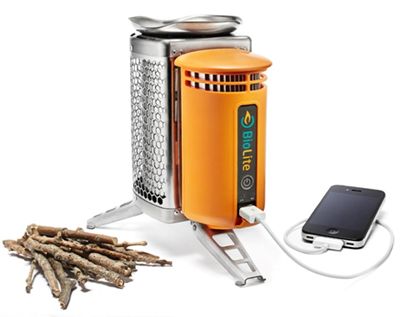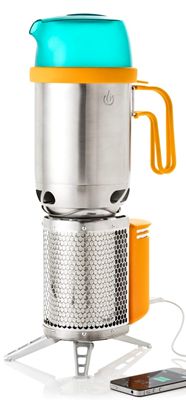
| Articles | Documents | Equipment | Events | Links | Membership | Miscellaneous | Scrapbook | Targets | What's New |
| Gear Review: BioLite Camp Stove | September 2014 | |||
| Dan Martinez
| ||||
|
“Check out this crazy thing:” was the subject line of the email I sent
to my sons when I discovered the BioLite Camp Stove. I had spotted this
thing in the backpacking stoves section at Sports Chalet. I was looking
for something else, so after a quick once-over I moved on. I wasn’t in
the market for a backpacking stove.
But while surfing the web a couple weeks later I learned what this thing
actually does, which prompted me to send the email off to my boys. It
is a small wood-burning stove that generates electricity. The electricity
it puts out is enough to top off the charge in your smart phone, or any
other small electronic device that charges through a USB port. Yeah, I
know: Huh?
The more I read up on it, the more and more I wanted one. With my
birthday coming up, my wife started asking me what gifts would be on
my wish list. I mentioned a compact solar panel for camping and the
BioLite stove. I didn’t get the solar panel, but my family all kicked
in to make me a new owner of a BioLite Camp Stove.
So how does it work? The BioLite Camp Stove consists of two main parts:
the stainless steel combustion chamber and the orange electronics module.
In use, the power module is attached to the side of the combustion
chamber. There is a copper probe that extends from the side of the power
module and pokes into the flame chamber. This is what makes the magic
happen.
The probe is attached to a device called a thermo-electric generator, or
TEG, in the electronics module. A TEG operates on a scientific principle
called the Seebeck effect, named after the Baltic German scientist
who in 1821 discovered that certain materials, when placed in contact with
each other, but kept at different temperatures, will generate an electric
current.
The primary purpose of generating electricity through heat is not charging
your smart phone, it is to run the fan.
The steel combustion chamber consists of three layers. The outermost is
a honeycomb perforated heat shield. The middle layer is a solid piece of
stainless steel sheet, but with a port to allow in fan air. The innermost
layer has a series of strategically placed air jets at the bottom, middle,
and the top sides of the fire chamber that circulate fan air to promote
very efficient combustion of the wood.
This type of a stove is known as a wood-gas stove. I guess that I never
understood how inefficient an open wood fire is. When wood burns it emits
a flammable gas. When a fire smokes, that is basically unburned wood-gas
plus flammable particulates that are not being burned, but just escaping
into the atmosphere. Besides oxygenating the fire, the fan of the
BioLite stove recirculates the wood gas and fine flammable particulates
back into the combustion chamber where they ignite and burn. As a result,
this little marvel burns wood practically smoke-free.
Once the fire gets hot enough for the TEG to produce enough electricity to
fully charge the fan battery, the excess electricity is made available to
the USB port so that you can charge your smart phone. This is signaled by
a LED on the front panel turning from orange to green. The fan has two
speed settings, controlled by a single pushbutton switch located above the
USB port.
To start the stove, you loosely pile a fistful of twigs into the fire
chamber. You can use scrap wood from your household woodworking projects
just as well. Fuel sticks of about 3” to 4” long, up to about ½ inch in
diameter seem to be optimum. Hardwoods are best, but softwoods work fine.
Softwoods just burn a little dirtier and need replenishment more often.
The drier the wood, the better. It helps to have a pile of prepared fuel
prior to starting the burn.
For starting, BioLite includes some fire starter sticks with the stove.
But here I have to reverse myself from something I said in last month’s
story. I mentioned Vaseline-soaked cotton balls as a fire starter, but
then I said that I prefer solid fuel tablets as tinder. Those fuel tabs
work great for starting a camp fire, but I can heartily recommend
Vaseline-soaked cotton balls for starting the BioLite.
After rubbing in a generous amount of Vaseline into a cotton ball, I
pulled it open to expose the maximum amount of surface area. I then
skewered the cotton onto the end of a 4” long wood sliver. With one
spark-showering-scrape of a ferro rod onto the cotton it immediately
ignited! I then grabbed the other end of the wood sliver and placed the
flame among the awaiting twigs in the BioLite’s fire hole. We have fire!
At first, you let the fire get going with no fan-assist. If the flame
is still weak, you risk blowing it out if you turn on the fan too soon.
You may get a little smoke at startup. When enough wood catches, you
can press the fan button once to start the fan on low. This will begin
circulating air around the fire chamber and you will see the fire turn
into a mini fire-tornado. Any smoke will now clear up as the fire
starts to burn cleanly.
To really get the fire roaring, keep feeding the fire, and push the fan
button once more to high speed. But here’s the thing: At high speed,
the rather small pieces of wood are quickly consumed and you basically
have to continually feed fuel into the voracious maw of the beast.
Plus at high speed, the fan noise becomes a small irritation factor,
and the fan consumes more electricity. The higher temperature
compensates for that by creating more electricity, but I prefer to
keep the fan at a soft whir on low speed. You still have to keep
feeding the fire every 5 minutes or so. You cannot just walk away to
attend to other camp chores.
And that explains how to turn off the stove. Basically, you just let
it run out of fuel. It doesn’t take long. The fan will turn itself
off when the stove cools down enough that the microprocessor decides
that it is no longer needed to protect the TEG. When all done, you
will be amazed at the tiny amount of ash that remains at the bottom of
the fire chamber. The BioLite burns wood very completely and efficiently.
The literature says that the stove can boil a liter of water in 4˝ minutes.
I have not timed it myself, but I have no reason not to believe that. So
far I have cooked up some Ramen noodles, roasted marshmallows, and warmed
up some hot chocolate with it, all in my back yard.
So really, why did I want this thing? That’s a little hard to answer.
First of all, the fuel for it is free, everywhere, and unlimited. No
buying propane canisters or liquid fuel – ever.
Then I have to admit that I am fascinated by the marriage of modern
electronics with one of man’s oldest survival technologies. It is
very fascinating to see the flame jets of wood gas that come out of
the holes at the top of the combustion chamber. The fan pulls the
wood gas into the air space between the walls of the stove and
re-injects it into the top of the fire chamber where it ignites and
burns, looking a lot like a propane flame.
The ability to charge a smart phone is cool, but it certainly was not
the big draw for me. I guess the biggest draw for me was looking
forward to firing it up in the pre-dawn or during a snowstorm while
sitting in a hunting blind freezing my ass off. I’ve been there too
many times. It is a perfect little portable campfire. And to be able
to warm up some hot chocolate at the same time? Sublime!
It is not a light backpacking stove however. It weighs just over 2
pounds. Backpackers may shun it for that reason, but that’s not too
heavy for me to consider packing it along in my ATV, or throwing it in
my pack when planning to sit in a hunting blind all day. If I was
planning a day of just hiking the hills, I would probably leave it
behind. But on second thought, a warm lunch might be nice.
I also received the BioLite KettlePot with the stove. The KettlePot
has a 1˝ liter (6 cup) liquid capacity and also doubles as a kind of
hard case for the stove, as the stove will nest inside. This makes
for a rather bulky and even heavier assemblage, probably too much for
your daypack, but fine for basecamp. Both the stove and the kettle
come with nylon drawstring storage sacks.
The BioLite Camp Stove costs about $130 most places. The KettlePot is
an additional $50. No, not cheap, but it is well designed and innovative.
To find out more, check it out at the
BioLite website.
| ||||
| If you enjoyed this story, or found it useful, please consider clicking here to join the NRA at a discount of $15 off the normal membership cost. You will be supporting both this website and adding your voice in support of the Second Amendment. Thank you very much. |

|

|
|


